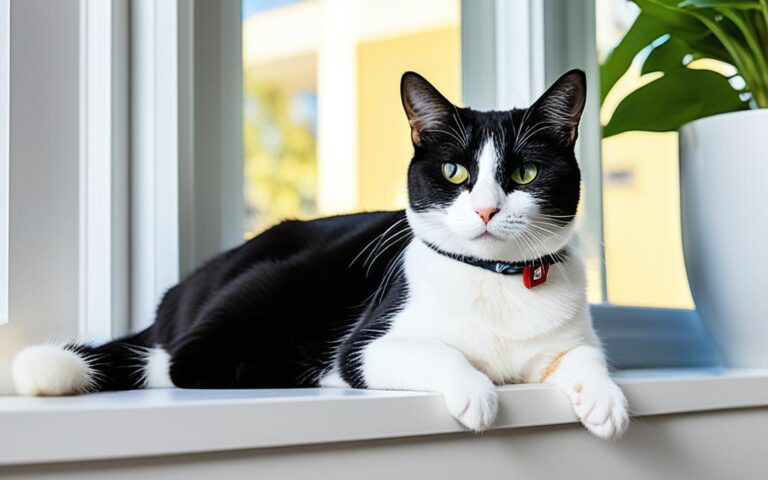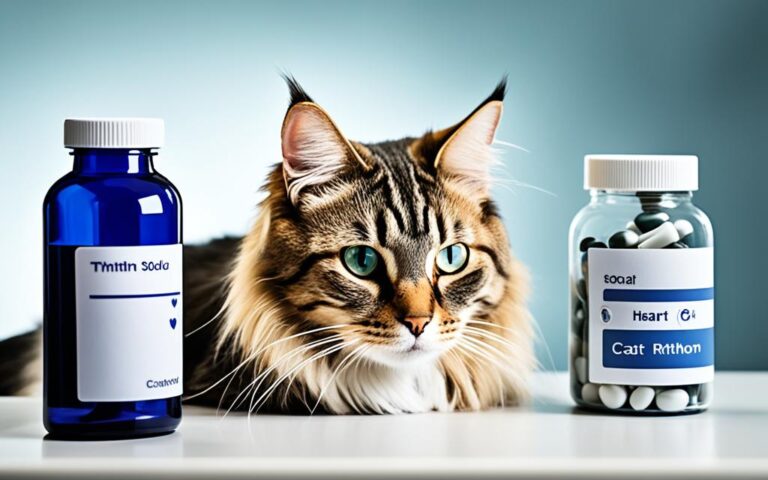Triamcinolone Acetonide for cats Uses and Benefits
Triamcinolone Acetonide is a synthetic glucocorticoid drug often used in cats. It treats acute arthritis, skin issues, and allergic reactions1. This medicine is known for fighting inflammation, offering relief for many feline diseases1.
This medication has an intermediate effect, working for days to weeks1. It’s designed for both human and animal use, with many generic versions available1. Triamcinolone Acetonide has a broad list of uses in cats, from arthritis to eye diseases and ear problems1.
Key Takeaways
- Triamcinolone Acetonide is a synthetic glucocorticoid drug used to treat acute arthritis, skin conditions, and allergic reactions in cats.
- It is available under brand names like Vetalog® and Panalog® and can provide relief for a variety of feline health issues.
- The drug is commonly used to address conditions such as acute arthritis, allergic reactions, skin conditions, muscle inflammation, lick granuloma, inflammatory eye diseases, and ear issues.
- Triamcinolone Acetonide is classified as a synthetic glucocorticoid with an intermediate duration of effect, lasting for days to weeks.
- It is registered for use in both humans and animals, with various generic preparations available.
Table of Contents
What is Triamcinolone Acetonide?
Overview and Brand Names
Triamcinolone Acetonide is a common drug in human and veterinary care. For people, it’s in drugs like Aristocort® and Kenacort®. In the pet world, Vetalog® and Panalog® are known brands2.
Drug Classification and Mechanism of Action
This drug is a type of anti-inflammatory, called a synthetic glucocorticoid. It helps stop the body from reacting too much to injury or swelling2. Triamcinolone works by blocking the release of certain cell substances. This reduces swelling by affecting the immune system’s actions3.
Animax® Ointment contains Triamcinolone. It’s mainly for ear and skin issues in cats and dogs4. Sizes include 30ml, 7.5ml, and 15ml4.
“Triamcinolone Acetonide is consistently rated 5 out of 5 stars by buyers, indicating its effectiveness and popularity in the pet care industry.”2
For severe joint issues in animals, there’s Triamcinolone Acetonide Injectable Suspension. This is also good for skin allergies and irritations3. It comes in 10 ml vials, made by Amneal Biosciences3.
Triamcinolone Acetonide for Cats: Uses and Applications
Triamcinolone Acetonide is a powerful medication for cats with many uses. It’s approved by the FDA. Vets often prescribe it for skin problems, allergies, and other inflammations in cats5.
It’s great for treating acute arthritis in cats. This medicine reduces joint pain and swelling. So, it helps cats with arthritis feel better5. Triamcinolone Acetonide is also good for fighting off allergic reactions in cats, like allergic skin problems and reactions to the environment5.
Besides skin issues and allergies, this medicine can also treat certain mouth and throat problems in cats. Vets might use it on the skin, in shots, or for the eyes and ears. They do this to handle different inflammatory problems5.
This medicine is helpful, but it must be used with care by a vet. If not used right, it can lower the immune system and cause other issues in cats5. It’s very important for vets to follow the right dose carefully. This makes sure the cats are safe and healthy while using this medicine5.
| Condition | Triamcinolone Acetonide Application |
|---|---|
| Acute Arthritis | Anti-inflammatory properties help reduce joint pain and swelling |
| Allergic Reactions (Contact Allergic Dermatitis, Atopy) | Can manage inflammatory response and provide relief |
| Feline Plasma-Cell Gingivitis-Pharyngitis | Can be used to treat inflammatory conditions in the mouth and throat |
| Feline Polymyopathy (Muscle Inflammation) | Can help reduce inflammation in muscle tissue |
To sum up, Triamcinolone Acetonide is a key treatment for many cat health problems. It’s good for skin issues, allergies, and muscle inflammation. But, it should always be used under a vet’s advice to keep the cats safe and sound5.

Administering Triamcinolone Acetonide to Cats
Dosage Guidelines and Frequency
The right dose of Triamcinolone Acetonide for cats changes based on the illness, how it’s given, and what the vet suggests. Sometimes, cats need 0.05 to 1 mg for every pound they weigh (0.11 to 2 mg/kg). They can get this dose from once every day to once every week6. If it’s a cream or a spray, it’s usually put on the problem spot two to four times a day. This depends on how bad the issue is7. Treat your cat for as long as the vet says, even if they look better before the treatment ends. Doing this stops the illness from coming back. Plus, it helps to keep the drug working well.
Directions for Use and Missed Dose Instructions
Give Triamcinolone Acetonide to your cat just like the vet shows you. For pills or shots, it should be given at the same time daily8. If you miss a dose, give it as soon as you remember, unless it’s almost time to give the next dose. Then, just forget about the missed one. Don’t try to give a double dose to catch up. This could be dangerous for your cat6.
When it’s time to stop, your cat can’t just quit the medication. There could be bad symptoms if you do. The vet will tell you the right way to stop, slowly.
“Completing the full course of treatment as prescribed is important, even if the cat’s condition improves, to prevent relapse or the development of resistance.”
Always do your best to give the right amount of Triamcinolone Acetonide as the vet advises to your cat. This helps your cat get better without any problems. By listening to your vet, you’re making sure your cat is safe and well678.
Potential Side Effects and Precautions
Triamcinolone Acetonide is safe and helpful for cats when used right. Still, some cats might have side effects9. The usual ones are vomiting, acting sad, and tired, always thirsty or hungry, and breathing hard9. Using it for a long time might make these problems worse, like losing hair, weak muscles, and getting sick easier9.
Contraindications and Special Considerations
Care is needed when giving Triamcinolone Acetonide to cats, and some shouldn’t get it at all. Cats that are allergic to it or those with certain health issues shouldn’t use this drug10.
The same caution goes for nursing cats. The drug can pass to kittens through milk and affect their growth10.
Owners must know the possible bad effects and limits of Triamcinolone Acetonide. Watching their cats closely is very important while they are taking this medicine. Telling the vet right away about any problems is key to using this drug safely with cats11.

“Responsible pet owners should work closely with their veterinarians to weigh the benefits and risks of using Triamcinolone Acetonide, and closely monitor their cats for any undesirable side effects.”
Triamcinolone Acetonide for Cats: Benefits and Efficacy
Triamcinolone Acetonide is very effective at fighting inflammation. It’s great for cats with many health issues12. This glucocorticoid can handle things like severe pain, itchy skin, and even serious swelling12. It’s helpful for skin problems caused by allergies or other immune issues13.
In Canada, there are 5 approved products that have glucocorticoids for cats. These include sprays, a gel, and a cream12. Triamcinolone acetonide, as a mid-strength option, does well against tough skin problems in cats12.
Triamcinolone acetonide has shown to be a helpful treatment for many cat health issues. It can manage joint pain, mouth and throat problems, and muscle issues13. This shows its broad use for several cat health concerns13.
Using this medicine right is very important. Doctors should choose the best type based on the cat’s condition and skin health12. Following these steps helps keep use of triamcinolone acetonide safe and effective for cats.
To wrap it up, Triamcinolone acetonide is a top pick for many cat health problems. It works well for skin issues, allergies, and various inflammations. It’s a key tool for vets dealing with these common cat problems131214.
Comparing Triamcinolone Acetonide to Similar Drugs
Triamcinolone Acetonide is a corticosteroid drug for cats’ inflammation and immune issues15. It works well but cost and side effects can differ. Vets look at these to pick the best option for a cat.
Efficacy, Cost, and Side Effect Profiles
Corticosteroids like Triamcinolone Acetonide are great at fighting inflammation thanks to their design16. Triamcinolone Acetonide stays longer in the ear, reaching areas that need help better15.
Many drugs can’t stay long in the ear, like dexamethasone-phosphate15. But, a form of dexamethasone in suspension can last over 3 months after use inside the ear15.
Triamcinolone comes as a cream under different names. Mupirocin is another option, sold as Bactroban and Centany17. Vets look at price and availability when choosing what to use.
Each cream can have its own set of side effects17. Triamcinolone cream might make skin red, itchy, or blister. Mupirocin cream could cause a headache or rash. Vets need to balance these with the drug’s benefits for their patients17.
Triamcinolone Acetonide and other drugs do a similar job15. But, what they cost and their side effects differ. Vets think about this, and their patient’s needs, when picking a treatment.
Triamcinolone Acetonide for Cats: Essential Drug Information
Triamcinolone Acetonide is a key drug in helping cats stay healthy6. It comes in many forms, like shots, ointments, and even syrup, making treatment flexible for different issues6.
Injectable Triamcinolone Acetonide has two strengths: 2 mg/ml and 6 mg/ml6. Panalog® cream mixes it with substances like nystatin for skin use6. There are also oral pills and a syrup version available6.
You can use Triamcinolone Acetonide in various ways, like putting it on skin, shots, or taking it by mouth, based on what the cat needs6. This allows treating each cat’s health problem in the best way6.
| Formulation | Concentration | Administration |
|---|---|---|
| Injectable Suspension | 2 mg/ml, 6 mg/ml | Injection |
| Panalog® Ointment | Triamcinolone Acetonide, Nystatin, Neomycin, Thiostrepton | Topical |
| Oral Tablets | 1 mg, 2 mg, 4 mg, 8 mg | Oral |
| Oral Syrup | Not specified | Oral |
Triamcinolone Acetonide is very useful in veterinary care6. It helps in Addison’s disease, fights inflammation, and can lower immune responses6. Vets often use it in ways not listed on the label for cats, dogs, and more6.
When using this drug, owners and vets should watch out for side effects and mixing problems618. It’s crucial to follow the right dosages to keep cats safe and get them better618.
In short, Triamcinolone Acetonide is a big help in vet care, with many types to choose from for cats6. Knowing what this drug is for and how to use it helps ensure cats get the best care6.
Conclusion
In short, Triamcinolone Acetonide is a key drug for cats’ health. It fights inflammation and helps with immune-related issues19. It’s very useful for skin problems and allergies19. However, it can cause side effects and needs careful handling20.
Vets choose the right amount of Triamcinolone Acetonide for each cat’s needs19. It works well for eye problems, improving signs quickly19. Also, it’s a good option for managing certain eye diseases19.
Given its many uses and safety, Triamcinolone Acetonide is important in cat care21. Vets must weigh its benefits against the risks. This way, they can make the best choices for their furry patients. They aim for great results and better life quality for cats.
FAQ
What is Triamcinolone Acetonide?
How is Triamcinolone Acetonide classified and how does it work?
What are the uses of Triamcinolone Acetonide for cats?
How is Triamcinolone Acetonide administered to cats?
What are the potential side effects of Triamcinolone Acetonide in cats?
Are there any contraindications or special considerations for using Triamcinolone Acetonide in cats?
How effective is Triamcinolone Acetonide in managing inflammatory and immune-mediated conditions in cats?
How does Triamcinolone Acetonide compare to similar corticosteroid drugs used in veterinary medicine?
What are the different formulations of Triamcinolone Acetonide available for use in cats?
Source Links
- Triamcinolone Acetonide (Vetalog®, Panalog®) for Dogs and Cats
- Triamcinolone
- Triamcinolone Acetonide Injectable Suspension USP, 400 mg/10 ml, 10 ml vial
- No title found
- Triamcinolone Acetonide for Dogs and Cats
- Triamcinolone Acetonide | VCA Animal Hospitals
- Vetalog Parenteral Veterinary – Drugs.com
- TriamTabs for Animal Use – Drugs.com
- Animax for Cats: Dosage, Safety & Side Effects – Cats.com
- Animax® Ointment
- Triamcinolone Acetonide Injection: Uses, Side Effects, Interactions, Pictures, Warnings & Dosing – WebMD
- Use of topical glucocorticoids in veterinary dermatology
- Topical therapies in veterinary dermatology
- What’s on Top or Is It? – The Use and Misuse of Systemic and Topical Medications in Breeding Animals – Tufts Breeding & Genetics 2015
- Comparison of the Pharmacokinetic Properties of Triamcinolone and Dexamethasone for Local Therapy of the Inner Ear
- Corticosteroids in Animals – Corticosteroids in Animals – Merck Veterinary Manual
- Triamcinolone Cream vs. Mupirocin Cream Treatment for Skin Problems: Differences and Side Effects
- DailyMed – DERMA-VET- nystatin, neomycin sulfate, thiostrepton and triamcinolone acetonide ointment
- Frontiers | Case Report: Clinical Remission in a Cat With Severe Bilateral Eosinophilic Keratitis Receiving Combined Immunosuppressive Therapy (Triamcinolone Acetonide and Tacrolimus)
- Contribution of oral triamcinolone to treating proliferative and necrotising otitis externa in a 14-year-old Persian cat
- Case Report: Clinical Remission in a Cat With Severe Bilateral Eosinophilic Keratitis Receiving Combined Immunosuppressive Therapy (Triamcinolone Acetonide and Tacrolimus)







